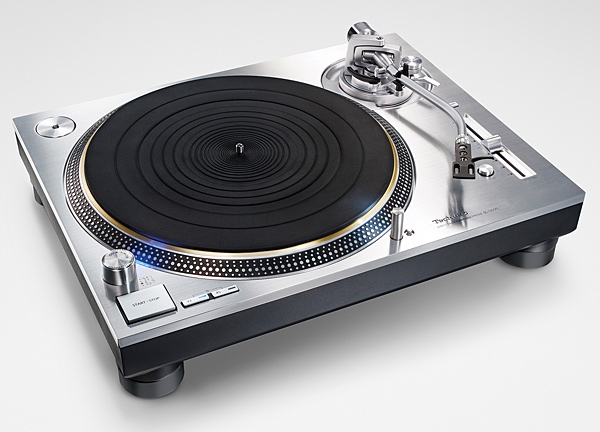
By the time the regular-production SL-1200G was released later in 2016—it was almost identical to the SL-1200GAE and cost the same—most people had realized that this was an entirely new design created for audiophiles, not a new version of the old ‘table that had come to be used mainly by DJs. But similitude is a powerful thing; while auditioning the SL-1200G, with its familiar pitch slider, strobe light, and hinged dust cover, I couldn’t not think about the SL-1200MK4 I had lived with and thoroughly enjoyed when I was in my 20s.
That deck had belonged to my friend M, who had lent it to me for what turned out to be almost a year. In late-1990s New York City, seemingly every coffee shop, hair salon, and picnic featured someone with two SL-1200s, a mixer, and a crate of records (a predicament immortalized by a DJ spinning graveside at a funeral in Zoolander). A member of the homegrown DJ brigade, M was taking a break from his gear for reasons I no longer recall. I had been playing LPs on a Rega Planar 3. One of the most recommendable turntables I can think of, the Rega imbued music with an excellent sense of rhythm, a decent amount of detail, and gobs of excitement and drama. The direct-drive Technics, though, went places the belt-drive Rega could not reach: Instead of the lighter ‘table’s dancing way with rhythm, the Technics produced an iron-fisted sense of drive and deeper, more physical bass. Powering thousands of dance floors worldwide, the seemingly unbreakable SL-1200 made music sound locked in and effortlessly propulsive, providing a different sort of drama from the lightweight Rega. But compared to the Rega, it sounded wooly and vague, and after a while I missed the British deck’s better-defined, more-refined presentation. When the time came, I returned the Technics to M without a pang of regret.

When I lifted the SL-1200G from its box this spring, the twinge in my upper arms told me this was not the DJ turntable of the Clinton years. Everything about this tanklike 39.7lb device feels different. Too much has already been written about the SL-1200G to require a full treatise on its construction, but some aspects are worth mentioning. The nearly 8lb platter is a sandwich of brass, aluminum, and rubber; it feels more precise, luxurious, and stable than any I’ve handled. (The balance of each deck is said to be adjusted at Technics’s factory in Malaysia, on equipment used to evaluate bullet-train wheels.)
The coreless motor eliminates cogging, speed anomalies resulting from the interaction between rotor magnets and stator slots on standard electric motors. According to the RPM Pro app on my iPhone, the Technics spun at precisely 33 1/3 rpm and produced an impressive 0.014% wow/flutter measurement. The SL-1200’s lamentable tonearm—easily the chintziest thing about that turntable—has been reimagined. The new armtube is made of cold-drawn magnesium, and the gimbal bearings reveal zero wiggle or twist.
The back of the SL-1200G offers two RCA jacks, a ground lug, and an IEC connector. (The substantial weight of the Technics enabled me to use the relatively thick and heavy AudioQuest Thunder power cable without affecting the turntable’s balance.) Finally, to my delight, the SL-1200G is able to spin at 78rpm, which extends its utility as a music playback device by about a half-century.

In use, the Technics makes most audiophile turntables seem a bit kludgy and crude. For one thing, it retains the high torque and nearly instant starts (spec’d at 0.7s) and stops that everyone loved about the original SL-1200 models. The precise-feeling cuing lever, large antiskate dial, lovely, polished-aluminum 45 insert (with its cutout housing on the chassis), and strobe light (changed from red to blue) appear perfectly machined and delight both the eye and hand. Even the action of the hinges in the dust cover is buttery smooth.
My favorite convenience, though, is the large, knurled disk under the tonearm base for setting VTA. Its grippiness and easy-to-read markings make dialing in tonearm height a pleasure and make the sliding pillar and grub-screw system on my Schick 12″ arm seem rather medieval. Everything about the Technics feels considered, rational, and well-executed, with that Japanese consideration of tactility and knack for visual harmony. I bet an unglazed Bizen vase holding a single flower would look nice beside it.

Dialing it in
I leveled the Technics on top of my Box Furniture Co. equipment stand by rotating its adjustable feet, then installed the Dynavector Te Kaitora Rua cartridge in its detachable headshell (using the heavier of the two supplied counterweights) and gave it a listen. In stock form, it sounded solid, agile, and impressively neutral, but also noticeably smaller, grayer, and more mechanical—with shorter note decay—than my Garrard 301/Schick/Box Furniture Co. record player. But as it happens—and as the internet will tell you at impressive length—the Technics is a tweaker’s dream. In fact, modifications are mandatory to unlock its formidable performance; fortunately, they also happen to be easy and noninvasive.
- Log in or register to post comments








